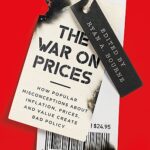Luis Alvarez/DigitalVision via Getty Images
The U.S. economy continues to show its resilience, but that strong performance isn’t as evident when looking at economic surveys. Brad Simpson, Chief Wealth Strategist at TD Wealth, looks at what he sees as the difference between evidence-based reason and irrational intuition.
Transcript
Kim Parlee – According to my next guest, when it comes to capturing the spirit of financial markets right now, they can be best described as a tale of two cities, that is, the duality between how the markets and the economy are performing versus how people actually feel.
That dichotomy is one of the central themes of the latest Quarterly Portfolio Strategy report by TD Wealth, entitled “The Best of Times and the Worst of Times.” Brad Simpson is the Chief Wealth Strategist at TD Wealth and here to talk about all of this. Nice to see you.
Brad Simpson – It’s nice to see you.
Kim Parlee – Great report, I just should just start by saying. I’ve gone through it, and it’s really, really great. Maybe just tell us why you’re talking about it’s the best of times, it’s the worst of times. Why was that the thematic?
Brad Simpson – Yeah, I mean, I confess, it’s a subject that I know that my own team is going to soon try to bump me off because I’m just fascinated by it. I’m not sure if I’ve ever seen a market this extreme and in this kind of idea of best and what’s really good and then, on the other side of this, this bad. And you have to start trying to square this somehow to say, how did we get here?
And, I mean, if you step back for a moment and not try to be so precise with every single number that you see and be tantalized by every data set that you see, and you go, well, inflation. Yeah, well, it’s not terrible anymore. It’s a lot better. Employment, well, employment is really darn good. The consumer, they’re pretty darn healthy and spending pretty freely.
All those things add up to a pretty good economy. And that usually ends up to a pretty good financial market. If all things are being equal in your middle of an economy that’s pretty good, your bond market’s usually pretty good, and your fixed income — or your equity market is usually pretty good. And both of those things would be the case. And then, of course, then, on the other side of the coin is that, if you do surveys of how people feel about things, boy, that’s a very, very different story. And so trying to sort between those two, really trying to come to terms with that is really what we spent 78 pages writing about. Now, the good news is, we have on our own brief, which is about 15 pages and a lot more digestible as well. But, really, that’s it.
Kim Parlee – It’s excellent analysis. Just so you know, I think it’s worth every page of the 78. But I do think that you’ve got some great charts here. And let’s bring them up. The first one is talking about how a tale of two cities – again, fear is not a verb. Part of this, I’m sure, is the fact that we actually have a news generator in our pockets all the time with our phone. And that has a lot to do with it. But tell me what we’re looking at here.
Brad Simpson – Well, yeah, well, what we’re looking at, and then I think the origins of it is that, on the one hand, we’re looking at it from the lows of last October to the upturn in run from equity markets, both the S&P TSX and the S&P 500. And let’s loosely say that, in that time, let’s call the S&P 500 up 25% to 26%. Let’s say the TSX is up somewhere around 17%. And, boy, I mean, I think, that’s a–
Kim Parlee – That’s a nice-looking chart.
Brad Simpson – And then, on the right-hand side is the growth of money market and cash in the United States and in Canada. And, boy, those are two different extremes. So when I look at them, what I see on both sides is, ultimately, it comes down to the conclusion, is an investor losing money? Because as both those equity markets are going up, and as if you’re putting cash into the market at that rate, which is usually driven by fear — the fact of the matter is you’re missing out on the return that’s going on, on the chart to the left. And so that’s really the cusp of when you sit back and go, well, why and how has this happened?
I think part of it comes down to is, it starts out with the media question. And we live in the middle of this media center, and you can’t turn the television on and not hear the word “Trump.” And then every time you don’t hear Trump, what you’ll hear about is war, which is understandable.
Kim Parlee – Yeah.
Brad Simpson – But we even hear about that in way less of terms. And, I mean, I look at the North American news stations I watch, and then I watch the global news stations that I watch, and I look at my North American newspapers I read, and you go — and I do a lot of that in a day. In the US, it’s just Trump, Trump, Trump, Trump.
And so what happens then is that both parties are very negative. And, of course, as you know, you pull out your phone. You read about it. And the algo finds out that that’s what you’re worried about, and it delivers it to you over and over and over again.
Kim Parlee – Confirmation bias, yeah. Yeah, yeah, yeah.
Brad Simpson – So you look at that, and then you go through this process of you still have — we had inflation very high. We still have memories of that inflation, but that inflation isn’t having as big of impact now. We’ve worked through the worst of those memories. And so then you look at this geopolitical part, and then you think that the consumers, when they’re spending, their debt payments are higher than they were before. There are reasons for them to be negative.
Kim Parlee – Yep, those are real, yep.
Brad Simpson – And so, I’m not trying to downplay that. But how negative these things are versus that — if you add them up, those two, the arithmetic doesn’t work there.
Kim Parlee – Yeah. Let’s look at the next one because I think this chart really illustrates exactly what you’re saying here, which you talk about the hard versus soft data. So what we’re looking at the screen here, take me through it, because that red arrow on the right is showing there’s a big difference between two things. What are we looking at?
Brad Simpson – Yeah, so, I confess, this really was the origins of our Portfolio Strategy Quarter was this chart, when we sat there and looked back and said, I don’t know if I’ve ever quite seen anything quite like this. And so when you look at the gold arrow on the way down, these are surveys. So you hear people like me or not and you’re doing your thing. What are we talking about? PMIs and ISMs, these are all surveys, right?
And so, a PMI, and you’ve got a purchasing manager’s index. You’re phoning, and you’re asking someone, and you’re going, how do you feel about what’s going on right now in your business? And you don’t know if they’re sitting in there watching the 24-hour court case on the most recent whatever political election is going on in the US.
And so, they’re feeling pretty negative about stuff. And they just finished watching war in Ukraine and war in Gaza, which are incredibly difficult to see. And then you respond to the question, well, how are things? Well, they’re pretty poor. Now, what we’re seeing on the other line is, looking at the–
Kim Parlee – I was just saying, let’s bring the chart up again so we can see it, but, yes.
Brad Simpson – Looking at the black line, that’s hard data, that’s looking at — that’s the stuff that you’d see, looking at home sales, pending new and existing, looking at the industrial sector, looking at orders, production, inventory, looking at the consumer’s health, their credit.
Kim Parlee – It’s actually what’s happening in the world.
Brad Simpson – Yeah, it’s the actual hard-to-measure things, and it’s very good. And that, to me, is incredibly telling, when you’re looking at the spread between those two. And it’s really important to know these things. I mean, because even a couple of days ago, I mean, all the headlines everywhere — ISM services index way lower than what we thought it was going to be. There’s a big slowdown imminent. And you’re like, well, wait a minute. Let’s not just hang everything on a data set like that. Let’s really be mindful of what that data is.
Kim Parlee – The bottom line with this also, too, is just that if you’re not in the market right now, there’s an opportunity cost that you’re not able to take advantage of what’s been happening in the equity markets.
Brad Simpson – Yeah, I think it’s two. I think that it’s–
Kim Parlee – Not just equity markets, sorry.
Brad Simpson – Yeah. I think, well, no, I think it’s you’re not invested in fixed income markets. You’re not invested in equity markets. It’s that one. And the other one, I think, which is — that is one of the by-products of the problem, the cure for the problem or the way to solve for that problem is that, one of the things I always say in my writing, it’s not what you think, it’s how you think.
And that’s where you have to really figure out is that, when you’re making these decisions, sit back and understand how you’re making those decisions. And if you can do that in a disciplined way, it’s a far more profitable strategy.
Kim Parlee – Some people are sitting beside the market right now a little worried because of how they feel. For those who have the discipline to get into the market, you have an overview of what asset classes from the wealth asset allocation committee perspective are attractive right now. Let’s start with fixed income.
Brad Simpson – Oh, boy, I mean, to me, that’s a great starting point. I think we all know about 2022 and the difficulties there and then the better returns in 2023, though late 2023. And I think, if we were really being clear about it, if we looked at the last two months, we’ve had 30-year Treasuries. So the further you go out with interest rates, the more susceptible to interest rate volatility is.
We’ve had a 30-year, 10-year – go up 48 basis points for a 30-year. Let’s call it 30 for a 10-year. And that means that bond markets have gone down on average. If you look at a spread, let’s call it 2% to 3%. And of course, then, so a lot of the returns that were experienced at the end of 2023 have gone back again. And part of this is on the back is that inflation has been more resilient and that interest rates have backed up a little bit. But, all that being said, you also have to look at the rates that are here today.
If you go and have a little bit longer time horizon, these are 10- to 12-year highs in interest rates. There’s not a lot higher for them to go. And so we are overweight there. We also say that you’re going to continue to experience volatility. But if you understand that and look at it in those terms, that’s a really good market to be investing in fixed income right now. And I say, you can’t do it by the calendar and say, okay, this is going to be the day. And I understand. I really do. I spent a lot of time with our clients over the last couple of years.
Kim Parlee – I know you live with this, yes.
Brad Simpson – Right? And I understand it’s a difficult decision, but it’s the right one.
Kim Parlee – Yeah, and so, modest overweight on the fixed income. Let’s go to equities, where you’re neutral. I’m going to ask to bring up a chart here which you explained to me right before, actually, that we talked here. But tell me what we’re looking at.
Brad Simpson – So one of the things that we’re looking at — what we’re looking at here is the green line is dispersion index. So what that’s saying is, in the S&P 500, that, in a really healthy equity market, you don’t have all the securities going up at the same time or you only have them doing nothing and a few, i.e., 2023, you just had a few that were moving, the Magnificent Seven, and we know that story. This is an incredibly positive chart for a healthy, healthy equity market.
Kim Parlee – And happy for active managers, right?
Brad Simpson – And it’s one that’s also really good for active managers. The S&P 500 as a whole, because of the top-heavy technology names, 21 times earnings, no one’s going to argue that’s an inexpensive market. But once you start getting into the rest of the market, you start getting it to be far more reasonably priced. And then, when you look at allocating to them, that means that when you have dispersion picking up like that, it’s actually turning into more of a business environment and then money flowing to the businesses that are doing the best inside of their sectors. And the ones who don’t tend to get punished quite quickly as well.
So for going both long, so owning things, it makes sense. My team, we’re also in the hedging business and protecting capital. It’s also a very good market to be hedging as well because the things that aren’t, you can be out and protectioning portfolios with shorting companies that aren’t in terribly good shape versus buying the ones that really are.
Kim Parlee – Yeah, the market is moving as it’s supposed to for the first time in a long time.
Brad Simpson – Absolutely is.
Kim Parlee – Let’s talk about alternatives where you are neutral right now. And I mean, alternatives, great for people also, but maybe not for those who have immediate liquidity needs. But–
Brad Simpson – Yeah, and it’s also a bit of a grab bag of–
Kim Parlee – Of many different things, yeah.
Brad Simpson – Yeah, of what goes in there. So, one, we have real estate in there, and I guess we’re highlighting that because we were both — we were maximum overweight domestic, our Canadian real estate and global real estate. And we have made this massive move from maximum underweight to underweight, so meaning I’m being a little facetious there. And so that is an improvement in what has been a very difficult market. However, I think some of the things that we do see is that many of the areas that are still strong in the United States are strong here. Your industrial ones, ones that are running off of AI and power centers, and those are areas that are still very good.
Anything that kind of residential and tower on that side, the bottom line is that we have more folks coming in here to live than we have places for them to live. And you’re not going to just solve that overnight. So that’s somewhat of a floor on that end as well. So for real estate, that’s why the change that we’ve made there.
We’ve also downgraded private debt. Now, the reason we didn’t talk about the fixed income is that, when we say private debt from our asset allocation committee, we’re basically talking about public issuers who do investment-grade debt, and they do it publicly and privately. We upgraded our investment-grade and our fixed income to overweight.
And so, by doing that, we said, okay, well, not only are we going to do that, we’re going to downgrade it on the private side. In public, it trades. It’s easier to get in, and now it’ll have a little bit more value there. So there’s really not much to read on that downgrade there either.
Kim Parlee – Brad, it is always a pleasure. Thanks for stopping by. We’ll talk to you again soon.
Brad Simpson – Thanks for having me.








